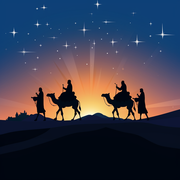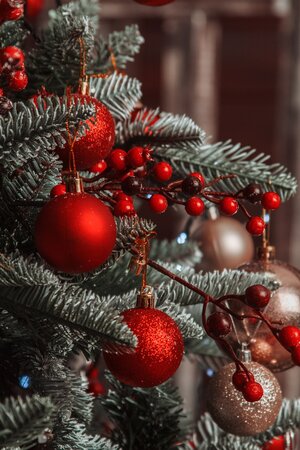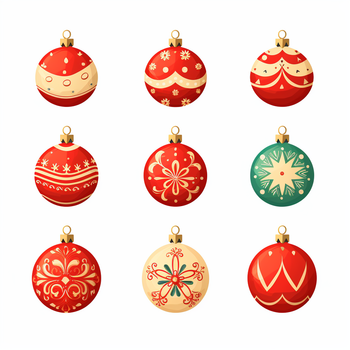Christmas tree
|
|
One of the most popular traditions associated with the celebration of Christmas, the Christmas tree is normally an evergreen conifer tree that is brought in the house or used in the open, and is decorated with Christmas lights and colourful ornaments during the days around Christmas.
| Contents |
History
The Christmas tree is often explained as a Christianization of the ancient pagan idea that the evergreen tree represents a celebration of the renewal of life. In Roman mosaics from what is today Tunisia, showing the mythic triumphant return from India of the Greek god of wine and male fertility, Dionysus (dubbed by some modern scholars as a life-death-rebirth deity), the god carries a tapering coniferous tree. Medieval legends, nevertheless, tended to concentrate more on the miraculous "flowering" of trees at Christmastime. A branch of flowering Glastonbury thorn is still sent annually for the Queen's Christmas table in the United Kingdom.
Among early Germanic tribes the Yule tradition was celebrated by sacrificing male animals, and slaves, by suspending them on the branches of trees. According to Adam of Bremen, in Scandinavia the pagan kings sacrificed nine males of each species at the sacred groves every ninth year. According to one legend, Saint Boniface attempted to introduce the idea of trinity to the pagan tribes using the cone-shaped evergreen trees because of their triangular appearance.
The modern custom, however, cannot be shown to be descended from pagan tradition directly. Its origins can be traced to 16th century Germany: Ingeborg Weber-Keller (Marburg professor of European ethnology) identified as the earliest reference a Bremen guild chronicle of 1570 which reports how a small fir was decorated with apples, nuts, dates, pretzels and paper flowers, and erected in the guild-house, for the benefit of the guild members' children, who collected the dainties on Christmas day. Another early reference is from Basel, where the taylor apprentices carried around town a tree decorated with apples and cheese in 1597. During the 17th century, the custom entered family homes. One Strassburg priest, Johann Konrad Dannerhauer, complains about the custom as distracting from the word of God. By the early 18th century, the custom had become common in towns of the upper Rhineland, but it had not yet spread to rural areas. Wax candles are attested from the late 18th century. The Christmas tree remained confined to the upper Rhineland for a relatively long time. It was regarded as a Protestant custom by the Catholic majority along the lower Rhine, and was spread there only by Prussian officials who were moved there in the wake of the Congress of Vienna in 1815. In the early 19th century, the custom became popular among the nobility and spread to royal courts as far as Russia. Princess Henrietta von Nassau-Weilburg introduced the Christmas tree to Vienna in 1816, and the custom spread across Austria in the following years. In France, the first Christmas tree was introduced in 1840 by the duchess of Orleans.
In Britain, the Christmas tree was introduced by King George III's German Queen Charlotte of Mecklenburg-Strelitz, but did not spread much beyond the royal family until the royal family Christmas centered round Prince Albert at Osborne House was illustrated in English magazines, and copied in the United States at Christmas 1850 (illustration, left). Such patriotic prints of the British royal family at Christmas celebrations helped popularise the Christmas tree in Britain and among the anglophile American upper class.
Traditionally, Christmas trees were not brought in and decorated until Christmas Eve (24 December), and then removed the day after twelfth night (i.e., 6 January); to have a tree up before or after these dates was even considered bad luck. Modern crass commercialisation of Christmas has however resulted in trees being put up much earlier; in shops often as early as late October (which every year attracts adverse comment from much of the shopping public). The most common tradition in U.S. homes is to put the tree up right after Thanksgiving (the fourth Thursday in November) and to take it down right after the New Year. In more northern climates and into Canada, the tree (if not too dry) and other decorations are left up well into January. In Europe, private Christmas trees are not usually put up until at least the middle of December and are always taken down by the 6th of January.
Many cities, towns, and department stores put up public Christmas trees outdoors for everyone to enjoy, such as the Rich's Great Tree in Atlanta, Georgia, USA and many others. In some cases the trees represent special commemorative gifts, such as in Trafalgar Square in London where the City of Oslo presents a tree to the people of London as token appreciation for the British support of Norwegian resistance during the Second World War and in Newcastle upon Tyne, where the 20 m tall main civic Christmas tree is an annual gift from the city of Bergen, Norway in thanks for the part played by soldiers from Newcastle in liberating Bergen from Nazi occupation.
Natural trees
European tradition prefers the open aspect of naturally-grown, unsheared trees (as in the photo, above right), while in North America (outside much of the Rockies) there is a preference for close-sheared trees with denser foliage, but less space to hang decorations. The shearing also damages the highly attractive symmetry of natural trees. In the past, Christmas trees were often harvested from wild forests, but now almost all are commercially grown on tree farms.
The best species for use are species of fir (Abies), which have the major benefit of not shedding the needles when they dry out, as well as good foliage colour and scent; but species in other genera are also used. Commonly used species in Northern Europe (including the UK) are:
- Silver Fir Abies alba (the original species)
- Nordmann Fir Abies nordmanniana (as in the photo)
- Noble Fir Abies procera
- Norway Spruce Picea abies (generally the cheapest)
- Serbian Spruce Picea omorika
- Scots Pine Pinus sylvestris
and in North America:
- Balsam Fir Abies balsamea
- Fraser Fir Abies fraseri
- Noble Fir Abies procera
- Red Fir Abies magnifica
- Douglas-fir Pseudotsuga menziesii
- Scots Pine Pinus sylvestris
- Stone Pine Pinus pinea (as small table-top trees)
Several other species are used to a lesser extent. Less-traditional conifers are sometimes used, such as Giant Sequoia, Leyland Cypress and Eastern Juniper. Virginia Pine is still available on some tree farms in the southeastern United States, however it has poor winter color and sharp needles. The long-needled Eastern White Pine is also used there.
Some trees are sold live with roots and soil, often from a nursery, to be planted later outdoors and enjoyed (and often decorated) for years or decades. However, the combination of root loss on digging, and the indoor environment of high temperature and low humidity is very detrimental to the tree's health, and the survival rate of these trees is low. These trees must be kept inside only for a few days, as the warmth will bring them out of dormancy, leaving them little protection when put back outside into the midwinter cold in most areas. Others are produced in a container and sometimes as topiary for a porch or patio.
Artificial trees
Artificial trees are very popular, particularly in the U.S., where despite their lack of realism (both in looks and scent), they are considered more convenient and (if used for several years) eventually less expensive than real trees. Some people simply store the whole decorated tree covered in a large bag, ready for the next year. In the U.S., about 70% of trees are now artificial. In most of Europe, artificial trees are still considered very bad taste, although even there electrical lights have replaced the candles in most households.
Artificial trees are sometimes even a necessity in some rented homes (especially apartment flats), due to the potential fire danger from a dried-out real tree, leading to their prohibition by some landlords. They may also be necessary for people who have an allergy to conifers.
Feather trees
The first artificial trees were tabletop feather trees, made from green-dyed goose feathers wound onto sticks drilled into a larger one, like the branches on a tree. Originating in Germany in the 19th century to prevent further deforestation, these "minimalist" trees show off small ornaments very well. The first feather trees came to the U.S. in 1913, in the Sears, Roebuck and Company catalog.
Modern trees
The first modern artificial Christmas trees were produced by companies which made brushes. They were made the same way, using animal hair (mainly pig bristles) and later plastic bristles, dyed pine-green colour, inserted between twisted wires that form the branches. The bases of the branches were then twisted together to form a large branch, which was then inserted by the user into a wooden pole (now metal with plastic rings) for a trunk. Each row of branches is a different size, color coded at the base with paint or stickers for ease of assembly.
Those first trees looked like long-needled pine trees, but later trees use flat PVC sheets to make the needles. Many also have very short brown "needles" wound in with the longer green ones, to imitate the branch itself or the bases that each group of pine (but not other conifer) needles grows from. These trees have become a little more realistic every year, with a few deluxe trees containing multiple branch styles. Many trees now come in "slim" versions, to fit in smaller spaces. Most of the better trees have branches hinged to the pole, though the less-expensive ones generally still come separately. Better trees also have more branch tips, the number usually listed on the box.
Around 2003, some trees with molded-plastic branches started selling in the U.S., intended to look more realistic, but at this stage still falling short in most cases.
Designer trees
The first trees which were not green were the metallic trees of the 1950s and 1960s. They were aluminium-coated paper, meaning that they also posed a great fire hazard if lights were put directly on them (warnings to this effect are still issued with most christmas tree lights). They were instead lit by a spotlight or floodlight, often with a motorized rotating color wheel in front of it. More recent tinsel trees can be used fairly safely with lights.
Other artificial trees which look nothing like a conifer except for the triangular or conical shape, are also used as tabletop decorations, such as a stack of ornaments.
Outdoor trees
Outdoor branched trees made out of heavy white-enameled steel wires have become more popular on U.S. lawns in the 2000s, along with 1990s spiral ones that hang from a central pole, both styles being lighted with standard miniature lights. These lights are usually white, but often are green, red, red/green, blue/white, blue, or multicolor, and sometimes with a small controller to fade colors back and forth.
A few hotels and other buildings, both public and private, will string lights up from the roof to the top of a small tower on top of the building, so that at night it appears as a lit Christmas tree, often using green or other coloured lights. Some skyscrapers will tell certain offices to leave their lights on (and others off) at night during December, creating a Christmas tree pattern.
Decoration and ornaments
Tinsel and several types of garland or ribbon are commonly used to decorate a Christmas tree. Delicate mould-blown and painted colored glass Christmas ornaments were a specialty of Czech glass factories from the late 19th century, and have since become a large industry, complete with famous-name designers. Lighting with candles or electric lights (fairy lights) is commonly done, and a tree topper completes the ensemble. Strands of tinsel may be hung in groups from longer branches to simulate icicles, though this trend has gradually fallen off since the late 1970s. Baubles are another extremely common decoration, and usually consist of a fairly small hollow glass or plastic sphere coated with a thin metallic layer to make them reflective, and then with a further coating of a thin pigmented polymer in order to provide colouration.
Individuals' decorations vary wildly, typically being an eclectic mix of family traditions and personal tastes; even a small unattractive ornament, if passed down from a parent or grandparent, may come to carry considerable emotional value and be given pride of place on the tree. Conversely, trees decorated by professional designers for department stores and other institutions will usually have a "theme"; a set of predominant colors, multiple instances of each type of ornament, and larger decorations that may be more complicated to set up correctly.
Many people also decorate outdoor trees with food that birds and other wildlife will enjoy, such as garlands made from unsalted popcorn or cranberries, orange halves, and seed-covered suet cakes.
Tree mats and skirts
Since candles were used to light trees until electric bulbs came about, a mat (UK) or "skirt" (US) was often placed on the floor below the tree to protect it by catching the dripping candle wax, and also to collect any needles that fall. Even when dripless candles, electric lights and artificial trees have been used, a mat is still usually used as a decorative feature. What began as ordinary cloth has now often become much more ornate, some having embroidery or being put together like a quilt.
A nativity scene, model train, or Christmas village may be placed on the mat or skirt, along with gifts (depending on tradition, all Christmas gifts, or those too large to be hung on the tree, as in "presents on the tree" of the song "White Christmas").
Generally, the difference between a mat and skirt is simply that a mat is placed under the tree stand, while a skirt is placed over it, having a hole in the middle for the trunk, with a slot cut to the outside edge so that it can be placed around the tree (beneath the branches) easily. A plain mat of fabric or plastic may also be placed under the stand and skirt to protect the floor from scratches or water.
Flocking
Although much less popular than in the 1980s, fluffy white flocking is sometimes sprayed on trees before decorating to simulate snow. While real snow settles in clumps atop branches, flocking is often sprayed all over the tree from the sides. While this is rather unrealistic, it still adds to the effect of a wintry fantasy. Flocking can be done with a professional sprayer at a tree lot (or the manufacturer if it is artificial), or at home from a spray can, and either can be rather messy. This tradition seems to be limited mostly to the United States.





